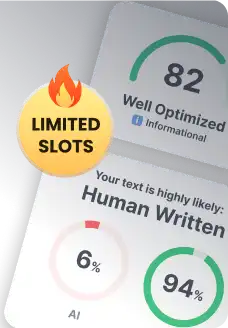In today’s fast-paced digital world, where information overload is the norm, capturing and holding a reader’s attention is no easy feat. Your blog’s format—the way you present your content—can be the difference between a fleeting glance and a loyal following. This concise guide will walk you through the steps of creating a blog format that’s not only visually appealing but also intuitively navigable.
Key Takeaways
- Understand the blog format by recognizing its key components, like headings, images, and links, to enhance readability.
- Follow clear steps when creating a blog post, such as brainstorming, drafting, and editing, to produce high-quality content.
- Explore different blog post types, like listicles and how-to guides, to diversify your content and attract a wider audience.
What is a Blog Format?
A blog format refers to the structure and layout used to organize content in a blog post. It includes elements like headings, paragraphs, images, and links. The primary goal of a blog format is to enhance readability and user experience, allowing readers to navigate the content easily.
Key components of an effective blog format include:
- Headings and Subheadings: Break up the text into sections, guiding readers through the content and highlighting key points.
- Short Paragraphs: Concise paragraphs help readers digest information quickly.
- Bullet Points and Lists: Enhance clarity by emphasizing key details and making the content easier to scan.
- Images and Media: Visual elements enhance the text and engage readers.
A well-structured format helps bloggers create content that fosters engagement and retention.
Importance of a Good Blog Format
The importance of blog format cannot be overstated. A clear, organized layout is essential for attracting and retaining readers. Here are several reasons why a proper blog format is essential:
- Enhances Readability: A good format improves readability, helping readers easily follow your content and stay engaged.
- Improves SEO: Search engines favor well-structured content. Using headings, subheadings, and lists makes it easier for search engines to crawl and understand your content, boosting rankings.
- Increases User Engagement: An appealing layout encourages readers to interact, whether by commenting, sharing, or subscribing.
- Supports Content Flow: A logical structure ensures a smooth flow of ideas, allowing each point to build on the previous one, creating a stronger argument or narrative.
- Facilitates Skimming: Many readers skim blogs. A good format allows them to quickly grasp the main points without missing key information.
Steps to Create a Blog Post
1. Choose Your Blog Topic
Selecting the right topic is crucial because it sets the tone for your post. Start by identifying your target audience, their interests, and the questions they may have. Use tools like Google Trends or keyword planners to find popular topics. Make sure your topic aligns with your expertise and passion to create authentic, engaging content.
2. Conduct Thorough Research
Research strengthens your blog’s credibility. Gather information from reputable sources like academic journals, industry reports, and expert interviews. Take notes and organize your findings to provide accurate data and statistics that enhance your argument. Remember, well-researched content builds trust with readers.
3. Decide on Post Type
Blog posts come in various formats: how-to guides, listicles, interviews, comparisons, or product roundups. Choose a format that fits your topic and audience preferences. For example, using a list for sharing tips or a narrative for storytelling could be more engaging. Align the format with your goals for maximum impact.
4. Make an Outline
Creating an outline is essential for structured writing. Start with your main idea, then break it down into sections and subsections. This will guide your writing process and ensure you cover all points thoroughly. An organized outline helps maintain flow and coherence throughout the post.
5. Write the Blog Content
Begin with a strong introduction that captures interest and introduces your topic. Use clear language and short sentences for readability. Break the text into short paragraphs to avoid overwhelming readers. Incorporate multimedia elements like images or videos to enhance engagement.
Want to try SurgeGraph for free?

Generate 20 documents

SEO tools (Auto Optimizer, Internal Linking, and more)

No credit card required
6. Craft a Catchy Headline
Your headline is the first thing readers see. Use relevant keywords to improve SEO visibility. A catchy headline should be informative yet intriguing, prompting readers to click through. Utilizing numbers, questions, or power words can make your headline more attention-grabbing.
7. Edit and Proofread Carefully
Refine your content by checking for grammatical errors, awkward phrasing, or unclear ideas. Reading aloud can help spot mistakes. Consider using editing tools for additional support. A polished post reflects professionalism and enhances credibility.
8. Add Metadata Details
Metadata includes titles, descriptions, and tags that help search engines understand your content better. Optimize these with relevant keywords related to your blog topic. This can significantly improve your blog’s visibility on search engines.
9. Publish Your Blog Post
Before publishing, check all links and formatting. Once published, promote your post via social media or email newsletters to reach a broader audience.
Different Blog Post Types
List Post Structure
List posts are among the most popular blog formats, presenting information clearly and concisely using numbered or bullet points. This format appeals to readers because it allows for quick scanning.
For example, a list post titled “10 Tips for Better Time Management” presents actionable insights that readers can easily digest. Each tip is distinct and often includes a brief explanation, making it straightforward to understand and apply.
This format is effective for several reasons:
- Easy to Read: Readers can quickly grasp the main ideas.
- Shareable: People love sharing lists on social media.
- SEO-Friendly: Search engines favor structured content, improving visibility.
How-to Guide Format
One of the common blog post formats is the how-to guide. These posts offer step-by-step instructions for completing specific tasks. For instance, a guide titled “How to Start a Vegetable Garden” would outline the process in manageable steps, including detailed explanations, tips, and images to support understanding.
The appeal of how-to guides lies in their practicality:
- Clarity: They provide clear instructions that anyone can follow.
- Value: Readers gain skills or knowledge that they can use immediately.
- Engagement: Well-structured guides keep readers on your page longer.
Interview Post Layout
Interview posts present conversations with experts or influential figures. This format is unique because it offers insights directly from knowledgeable sources. An interview post titled “An Interview with a Successful Entrepreneur” could reveal valuable lessons learned from real-world experiences.
These posts engage readers in several ways:
- Authenticity: Direct quotes add credibility.
- Diverse Perspectives: Interviews can cover various topics and viewpoints.
- Connection: Readers feel connected to the personalities involved.
Want to try SurgeGraph for free?

Generate 20 documents

SEO tools (Auto Optimizer, Internal Linking, and more)

No credit card required
Comparison Post Layout
Comparison posts evaluate two or more products, services, or ideas, presenting their pros and cons side by side. This format assists readers in making informed decisions by highlighting key differences and similarities.
For example, a comparison post on “iPhone vs. Android: Which is Better?” would break down features, price, performance, and user experience for each platform. The strength of comparison posts lies in their objectivity and support for decision-making. Readers appreciate unbiased assessments that guide them toward the best option for their needs.
Utilizing tables or charts effectively organizes information and facilitates easy comparisons. This approach attracts readers actively seeking solutions, positioning your blog as a reliable resource.
Product Roundup Layout
Product roundup posts curate a collection of top products within a specific category, providing brief descriptions and recommendations. This format serves as a convenient resource for readers exploring their options before making a purchase.
For instance, a roundup titled “Best Wireless Earbuds Under $100” would showcase several models, highlighting key features and price points.
The advantage of product roundup posts lies in their conciseness and helpfulness. Readers appreciate curated lists that save them time and effort in researching products, making it easier for them to explore their options.
Incorporating affiliate links can monetize these posts while delivering value to your audience. Eye-catching visuals and concise descriptions enhance their overall appeal, attracting purchase-ready consumers and driving traffic and potential sales for your blog.
Frequently Asked Questions
Are there any rules for writing a blog?
Yes, key rules include knowing your audience, maintaining a clear structure, using engaging headlines, and incorporating visuals. Consistency in voice and style is also essential for building trust.
How do you write a perfect blog?
To write a perfect blog, focus on a specific topic, provide valuable insights, use an engaging tone, and optimize for SEO. Edit thoroughly and encourage reader interaction through comments or shares.
What is the best format for a blog post?
The best format typically includes an attention-grabbing title, an introduction, subheadings for organization, bullet points for clarity, and a conclusion with a call to action. Visuals also enhance engagement.
How not to write a blog?
Avoid long paragraphs, jargon, and irrelevant information. Don’t neglect proofreading or skip SEO optimization. Lastly, steer clear of a monotonous tone that can disengage readers.
Should a blog have a home page?
Yes, a home page provides an overview of your blog’s content and purpose. It helps visitors navigate easily and encourages them to explore further, enhancing user experience and retention.





